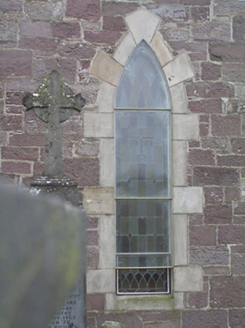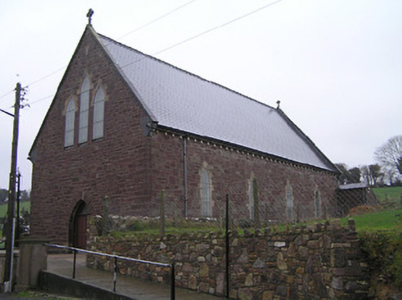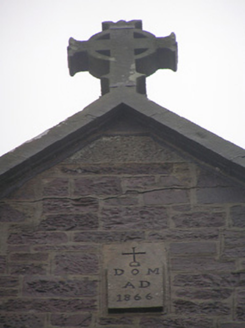Survey Data
Reg No
12403901
Rating
Regional
Categories of Special Interest
Architectural, Artistic, Historical, Social
Original Use
Church/chapel
In Use As
Church/chapel
Date
1865 - 1870
Coordinates
250962, 121361
Date Recorded
14/12/2004
Date Updated
--/--/--
Description
Detached four-bay double-height Gothic Revival Catholic church, dated 1866, with single-bay double-height lower chancel to east having single-bay single-storey sacristy to south-east. Pitched slate roofs with clay ridge tiles, cut-limestone coping to gables having cross finials to apexes, and cast-iron rainwater goods on cut-sandstone eaves having corbels. Random tooled dressed red sandstone walls with cut-stone date stone to gable, and unpainted rendered walls to chancel. Pointed-arch window openings (grouped in three-part arrangement over entrance to west) with cut-sandstone block-and-start surrounds (tooled cut-red sandstone block-and-start surrounds to west rising into cut-sandstone block-and-start surrounds), and fixed-pane fittings having square-leaded stained glass panels. Pointed-arch door opening with cut-sandstone dressings, tooled squared red sandstone voussoirs, replacement timber double doors having sidelights on panelled risers, and overlight. Full-height interior open into roof with decorative clay tile to aisle, timber pews, carved timber Gothic-style stations, timber roof construction on corbels, pointed-arch chancel arch with Corinthian colonette reveals supporting moulded archivolt, Gothic-style fittings to raised chancel, and pointed-arch 'reredos' (with sill supporting "Pieta", and Corinthian colonettes supporting moulded archivolt). Set back from line of road in own grounds on an elevated site. (ii) Graveyard to site with various cut-stone markers, pre-1840-present.
Appraisal
Superseding an earlier Catholic chapel indicated on archival editions of the Ordnance Survey a modest-scale rural parish church represents the continuation of a long-standing ecclesiastical presence in Killinaskpick (Kilnaspic) and the environs. Exhibiting an austere quality typical of many churches built in the mid nineteenth century the architectural design value of the composition is identified by the careful balanced arrangement of the openings producing a Gothic Revival theme. The construction in tooled sandstone exhibits fine stone masonry while dressings in sandstone of an alternative hue introduce an element of polychromy to the site. Having been well maintained the church presents an early aspect with substantial quantities of the historic fabric surviving in place both to the exterior and to the interior where decorative dressings embellish the pleasing design aesthetic of the site. Positioned on a slightly elevated site the setting value of the church is enhanced by an attendant graveyard containing markers of artistic merit dating back to the earlier chapel in the grounds.





